Database NORAD-Atomic-Data for Atomic Processes in Plasma
Abstract
1. Introduction: NORAD-ATOMIC-DATA
1.1. Photoexcitation and De-Excitation
- Line strength (S),
- Oscillator strength (f),
- Radiative decay rate (A-value)
- Lifetimes
1.2. Photoionization
- Total photoionization cross-section () of each bound state of the ion, from ground to various excited states, typically with 10. Total corresponds to the summed contribution of all ionization channels leaving the residual ion in the ground and various excited states.
- Partial photoionization cross-section () for all bound states of the ion for leaving the residual ion in the ground state only.
- Partial photoionization cross-sections () corresponding to leaving the residual ion in the ground and various excited states. NORAD-Atomic-Data provides these cross-sections only for the ground level of the ion. Photoionization resonances are often dissolved by plasma density and temperature, resulting in an enhanced continuum background. However, the strong and isolated resonances can be seen in the absorption spectra. Large quantities photoionization cross-section for all possible bound states with a wide range of photon energies are needed to determine the opacity in astrophysical plasmas.
1.3. Electron–Ion Recombination
- Level-specific total recombination (includes both RR and DR) rate coefficients () of all bound levels with 10.
- Total recombination rate coefficient (), summed contributions of all levels with 10 and of levels with 10 as function of electron temperature T.
- Total recombination cross sections () and total recombination rate coefficient () with respect to photoelectron energy E. Recombination resonances can be seen in emission spectra as dielectronic recombination lines. Total is needed for the determination of ionization fractions in photoionized or collisional plasmas.
1.4. Electron–Impact Excitation (EIE)
- Collision strength (),
- Effective collision strengths (),
- Collision rate coefficients ().
1.5. The Opacity Project and atomic database TOPbase
1.6. The Iron Project and atomic database TIPbase
1.7. NORAD-ATOMIC-DATA and Atomic Astrophysics and Spectroscopy
- -
- Significant part of the data corresponds to new and/or improved results over those in TOPbase,
- -
- The data are of higher accuracy than those in TOPbase,
- -
- Includes fine structure oscillator strengths of many ions,
- -
- Contains forbidden transitions, lifetimes,
- -
- Includes data of the additional atomic process of electron–ion recombination,
- -
- Contains larger sets (typically up to n = 10 and 9) of energy levels, photoionization cross-sections, recombination cross sections and rate coefficients needed for complete modeling of astrophysical objects,
- -
- Contains X-ray transition data for heavier elements (beyond Ni) which are of great interest for various astronomical, biomedical, fusion plasma applications.
2. Theoretical Approximations
2.1. Photoexcitations/ Deexcitations
2.2. Photoionization (PI)
2.3. Electron–Ion Recombination
2.4. Electron Impact Excitation (EIE)
3. Data Description of NORAD-Atomic-Data
4. Accuracy of Data and Benchmarking
- (i)
- from less than 1 to 20% in coupling approximation,
- (ii)
- from less than 1 to 50% for fine-structure splitting of LS multiplets using algebraic transformation,
- (iii)
- from less than 1 to 15% for relativistic Breit–Pauli approximations.
- (1)
- (2)
- (3)
- (4)
- (5)
- with pulsed-laser excitation and ionization atoms in an atomic beam at University of Nebraska [124].
- Engineering: Adeneh et al. [129] who studied thermodynamic and radiative properties of electrical discharge machining (EDM) plasmas for temperature up to 10,000 K and pressure range 0.1–1 MPa using atomic data from NORAD-Atomic-Data, find an increase in net emission coefficient (NEC) with different amount of iron contamination in nitrogen and sharp cooling of the plasma by iron contamination as shown in Figure 7 taken from [129].
5. Conclusions
- (i)
- include more data with publications,
- (ii)
- include computer programs that can read the data files and process the data to calculate the quantities of interest,
- (iii)
- introduce a plotting feature,
- (iv)
- an option for selection of partial data, such as, for a particular wavelength range.
Funding
Acknowledgments
Conflicts of Interest
References
- Nahar, S.N. NaharOSURadiative(NORAD)-Atomic-Data. The Ohio State University. 2007. Available online: http://norad.astronomy.osu.edu/ (accessed on 27 September 2020).
- IAEA Data page for database links. Available online: https://www-amdis.iaea.org/databases.php (accessed on 27 September 2020).
- CfA Harvard Data for database links. Available online: https://www.cfa.harvard.edu/amp/ampdata/databases.html (accessed on 27 September 2020).
- The Opacity Project; The Opacity Project Team, Institute of Physics Publishing: London, UK, 1995; Volume 1.
- Hummer, D.G.; Berrington, K.A.; Eissner, W.; Pradhan, A.K.; Saraph, H.E.; Tully, J.A. Atomic data from the IRON Project. 1: Goals and methods. Astron. Astrophys. 1993, 279, 298–309. [Google Scholar]
- Cunto, W.; Mendoza, C.; Ochsenbein, F.; Zeippen, C.J. TOPbase at the CDS. Astron. Astrophys. 1993, 275, L5–L8. [Google Scholar]
- TOPbase. 1992. Available online: http://cdsweb.u-strasbg.fr/topbase/topbase.html (accessed on 27 September 2020).
- TIPbase. 2001. Available online: http://cdsweb.u-strasbg.fr/tipbase/home.html (accessed on 27 September 2020).
- Seaton, M.J. Atomic data for opacity calculations. I. General description. J. Phys. B 1987, 20, 6363–6378. [Google Scholar] [CrossRef]
- Berrington, K.A.; Burke, P.G.; Butler, K.; Seaton, M.J.; Storey, P.J.; Taylor, K.T.; Yan, Y. Atomic data for opacity calculations. II. Computational methods. J. Phys. B 1987, 20, 6379–6397. [Google Scholar] [CrossRef]
- Berrington, K.A.; Eissner, W.; Norrington, P.H. RMATRIX1: Belfast atomic R-matrix codes. Comput. Phys. Commun. 1995, 92, 290–420. [Google Scholar] [CrossRef]
- Nahar, S.N.; Pradhan, A.K. Atomic Data For Opacity Calculations: XVI. Photoionization and oscillator strengths of Si-like ions Si0, S2+, Ar4+, Ca6+. J. Phys. B 1993, 26, 1109. [Google Scholar] [CrossRef]
- Nahar, S.N. Transition probabilities for dipole allowed fine structure transitions in Si-like ions: Si I, S III, Ar V, and Ca VII. Phys. Scr. 1993, 48, 297. [Google Scholar] [CrossRef]
- Nahar, S.N.; Pradhan, A.K. Large-scale Breit-Pauli R-matrix calculations for transition probabilities of Fe V. Phys. Scr. 2000, 61, 675–689. [Google Scholar] [CrossRef]
- Nahar, S.N. Oscillator Strengths and Transition Probabilities from Breit-Pauli R-matrix Method: Ne IV. At. Data Nucl. Data Tables 2014, 100, 1322–1336. [Google Scholar] [CrossRef]
- Nahar, S.N.; Pradhan, A.K. Electron-ion recombination in the close coupling approximation. Phys. Rev. Lett. 1992, 68, 1488–1491. [Google Scholar] [CrossRef]
- Nahar, S.N.; Pradhan, A.K. Unified Treatment of Electron-Ion Recombination in the Close Coupling Approximation. Phys. Rev. A 1994, 49, 1816. [Google Scholar] [CrossRef] [PubMed]
- Nahar, S.N. Total electron-ion recombination for Fe III. Phys. Rev. A 1996, 53, 2417–2424. [Google Scholar] [CrossRef] [PubMed]
- Eissner, W.; Jones, M.; Nussbaumer, H. Techniques for the calculation of atomic structures and radiative data including relativistic corrections. Comput. Phys. Commun. 1974, 8, 270–306. [Google Scholar] [CrossRef]
- Nahar, S.N.; Eissner, W.; Chen, G.X.; Pradhan, A.K. Atomic data from the Iron Project-LIII. Relativistic allowed and forbidden transitionstic probabilities for Fe XVII. Astron. Astrophys. 2003, 408, 789–8016. [Google Scholar] [CrossRef]
- Burke, P.G.; Robb, W.D. R-matrix theory of atomic processes. Adv. At. Mol. Phys. 1975, 11, 143–214. [Google Scholar]
- OPServer Site. Available online: http://opacities.osc.edu (accessed on 27 September 2020).
- Pradhan, A.K.; Nahar, S.N. Atomic Astrophysics and Spectroscopy; Cambridge University Press: Cambridge, UK, 2011. [Google Scholar]
- Bell, R.H.; Seaton, M.J. Dielectronic recombination: I. General theory. J. Phys. B 1985, 18, 1589–1629. [Google Scholar] [CrossRef]
- Zhang, H.L.; Nahar, S.N.; Pradhan, A.K. Close coupling R-matrix calculations for electron-ion recombination cross sections. J. Phys. B 1999, 32, 1459–1479. [Google Scholar] [CrossRef]
- Nahar, S.N. Fine structure transitions in Fe XIV. New Astron. 2013, 21, 8–16. [Google Scholar] [CrossRef]
- NIST. Available online: https://physics.nist.gov/PhysRefData/ASD/levels_form.html (accessed on 27 September 2020).
- Nahar, S.N. Allowed and Forbidden Transition Parameters for Fe XV. At. Data Nucl. Data Tables 2009, 95, 577–605. [Google Scholar] [CrossRef]
- Nahar, S.N.; Pradhan, A.K.; Montenegro, M. Resonant theranostics: A New Nano-Biotechnological Method for Cancer Treatment Using X-ray Spectroscopy of Nanoparticles. In Simulations in Nanobiotechnology; Eom, K., Ed.; CRC Press-Taylor & Francis Group: Boca Raton, FL, USA, 2011; pp. 305–330. [Google Scholar]
- Nahar, S.N. Characteristic features in photoionization of Fe XIX. New Astron. 2019, 73, 101277. [Google Scholar] [CrossRef]
- Nahar, S.N. Photoionization of fine structure levels of Ne III. New Astron. 2019, 67, 97–102. [Google Scholar]
- Nahar, S.N. Photoionization of Ca XV with high energy features. New Astron. 2017, 51, 69–73. [Google Scholar]
- Nahar, S.N. Photoionization cross sections of ground and excited levels of P II. New Astron. 2017, 50, 19–24. [Google Scholar]
- Nahar, S.N.; Pradhan, A.K. Reply to Comment by Blancard et al. (2016) on “Large Enhancement in High-Energy Photoionization of Fe XVII and Missing Continuum Plasma Opacity”. Phys. Rev. Lett. 2016, 117, 249502. [Google Scholar] [PubMed]
- Nahar, S.N.; PRadhan, A.K. Large enhancements in high-energy photoionization of Fe XVII and missing continuum plasma opacity. Phys. Rev. Lett. 2016, 116, 235003. [Google Scholar]
- Nahar, S.N. Photoionization and electron-ion recombination of Ti I. New Astron. 2016, 46, 1–8. [Google Scholar]
- Bailey, J.E.; Nagayama, T.; Loisel, G.P.; Rochau, G.A.; Blancard, C.; Colgan, J.; Cosse, P.; Faussurier, G.; Fontes, C.J.; Gilleron, F.; et al. A higher-than-predicted measurement of iron opacity at solar interior temperatures. Lett. Nat. 2015, 517, 56–59. [Google Scholar]
- Nahar, S.N. Photoionization of Ar XVI and Ar XVII. J. Quant. Spectrosc. Radiat. Transf. 2013, 117, 15–20. [Google Scholar]
- Nahar, S.N. Photoionization and Electron-Ion Recombination of Fe XVII for high temperature plasmas. J. Quant. Spectrosc. Radiat. Transf. 2012, 113, 1762–1770. [Google Scholar]
- Nahar, S.N.; Pradhan, A.K.; Chen, G.X.; Eissner, W. Highly Excited Core Resonances in Photoionization of Fe XVII: Implications for Plasma Opacities. Phys. Rev. A 2011, 83, 053417. [Google Scholar]
- Nahar, S.N. High Accuracy Radiative Data for Plasma Opacities. Can. J. Phys. 2011, 89, 439–449. [Google Scholar] [CrossRef]
- Nahar, S.N.; Montenegro, M.; Eissner, W.; Pradhan, A.K. Low Energy Fine Structure Resonances in Photoionization of O II. Phys. Rev. A Brief Rep. 2010, 82, 065401. [Google Scholar] [CrossRef]
- Nahar, S.N. Photoionization and electron ion recombination of He I. New Astron. 2010, 15, 417–426. [Google Scholar] [CrossRef]
- Nahar, S.N. Electron-Ion Recombination and Photoionization of Fe XXI. J. Quant. Spectrosc. Radiat. Transf. 2008, 109, 2731–2742. [Google Scholar] [CrossRef]
- Nahar, S.N. Photoionization cross sections of Fe XXI. J. Quant. Spectrosc. Radiat. Transf. 2008, 109, 2417–2426. [Google Scholar] [CrossRef]
- Nahar, S.N. Electron-Ion Recombination Rate Coefficients and Photoionization Cross Sections for Al XI, Al XII, Si XII, Si XIV for UV and X-ray modeling. New Astron. 2008, 13, 619–638. [Google Scholar] [CrossRef][Green Version]
- Nahar, S.N. Electron-Ion Recombination Rate Coefficients and Photoionization Cross Sections for S XIV and S XV for X-ray and UV modeling. Open Astron. J. 2008, I, 1–26. [Google Scholar] [CrossRef]
- Nahar, S.N. Electron-Ion Recombination Rate Coefficients and Photoionization Cross Sections for Astrophysically Abundant Elements. XII. Na IX, Na X, Mg X, and Mg XI for UV and X-ray modeling. Astrophys. J. Suppl. 2006, 167, 315. [Google Scholar] [CrossRef]
- Nahar, S.N. Electron-Ion Recombination Rate Coefficients and Photoionization Cross Sections for Astrophysically Abundant Elements. XI. N V-VI and F VII-VIII for UV and X-ray modeling. Astrophys. J. Suppl. 2006, 164, 280. [Google Scholar] [CrossRef]
- Nahar, S.N.; Pradhan, A.K. Electron-Ion Recombination Rate Coefficients and Photoionization Cross Sections for Astrophysically Abundant Elements. X. Ne VIII and Ne IX for UV and X-ray modeling. Astrophys. J. Suppl. 2006, 162, 417. [Google Scholar] [CrossRef]
- Nahar, S.N. Electron-Ion Recombination Rate Coefficients and Photoionization Cross Sections for Astrophysically Abundant Elements. IX. Ni XXVI and Ni XXVII for UV and X-ray modeling. Astrophys. J. Suppl. 2005, 158, 80. [Google Scholar] [CrossRef][Green Version]
- Nahar, S.N.; Pradhan, A.K. Self-Consistent R-matrix Approach To Photoionization And Unified Electron-Ion Recombination. In Special Issue on Photoeffect; Radiation Physics and Chemistry; Pratt, R.H., Manson, S.T., Eds.; Elsevier: Amsterdam, The Netherlands, 2004; Volume 70, pp. 323–344. [Google Scholar]
- Nahar, S.N. Electron-Ion Recombination Rate Coefficients and Photoionization Cross Sections for Astrophysically Abundant Elements VIII. Ar XIII with new features. Astrophys. J. Suppl. 2004, 156, 93–103. [Google Scholar] [CrossRef]
- Delahaye, F.; Nahar, S.N.; Pradhan, A.K.; Zhang, H.L. Resolution and accuracy of resonances in R-matrix cross sections. J. Phys. B 2004, 37, 2585. [Google Scholar] [CrossRef]
- Nahar, S.N.; Pradhan, A.K. Electron-Ion Recombination Rate Coefficients, Photoionization Cross Sections for Astrophysically Abundant Elements. VII. Relativistic calculations for O VI and O VII for UV and X-ray modeling. Astrophys. J. Suppl. 2003, 149, 239. [Google Scholar] [CrossRef]
- Pradhan, A.K.; Chen, G.X.; Delahaye, F.; Nahar, S.N.; Oelgoetz, J. X-ray absorption via Kα resonance complexes in oxygen ions. Mon. Not. R. Astron. Soc. 2003, 341, 1268. [Google Scholar] [CrossRef]
- Nahar, S.N.; Bautista, M.A. Electron-Ion Recombination Rate Coefficients and Photoionization Cross Sections for Astrophysically Abundant Elements VI. Ni II. Astrophys. J. Suppl. 2001, 137, 201. [Google Scholar] [CrossRef][Green Version]
- Zhang, H.L.; Nahar, S.N.; Pradhan, A.K. Relativistic close coupling calculations for photoionization and recombination of Ne-like Fe XVII. Phys. Rev. A 2001, 64, 032719. [Google Scholar] [CrossRef]
- Nahar, S.N.; Pradhan, A.K.; Zhang, H.L. Electron-Ion Recombination Rate Coefficients and Photoionization Cross Sections for Astrophysically Abundant Elements. V. Relativistic Calculations for Fe XXIV and Fe XXV for X-ray Modeling. Astrophys. J. Suppl. 2001, 133, 255–267. [Google Scholar] [CrossRef]
- Nahar, S.N.; Pradhan, A.K.; Zhang, H.L. Electron-Ion Recombination Rate Coefficients and Photoionization Cross Sections for Astrophysically Abundant Elements IV. Relativistic calculations for C IV and C V for UV and X-ray modeling. Astrophys. J. Suppl. 2000, 131, 375–389. [Google Scholar] [CrossRef]
- Nahar, S.N. Electron-Ion Recombination Rate Coefficients and Photoionization Cross Sections for Astrophysically Abundant Elements III. Si-Sequence Ions: Si I, S III, Ar V, Ca VII, Fe XIII. Astrophys. J. Suppl. 2000, 126, 537. [Google Scholar] [CrossRef][Green Version]
- Nahar, S.N.; Bautista, M.A. Electron-ion recombination of Fe V. Astrophys. J. Suppl. 1999, 120, 327. [Google Scholar] [CrossRef][Green Version]
- Nahar, S.N. Electron-Ion Recombination Rate Coefficients, Photoionization Cross Sections, and Ionization Fractions for Astrophysically Abundant Elements II. Oxygen Ions. Astrophys. J. Suppl. 1999, 120, 131. [Google Scholar] [CrossRef]
- Nahar, S.N.; Bautista, M.A.; Pradhan, A.K. Electron-ion recombination of Fe IV. Phys. Rev. A 1998, 58, 4593. [Google Scholar] [CrossRef]
- Nahar, S.N. Photoionization cross sections and oscillator strengths for oxygen ions: O I-O VIII. Phys. Rev. A 1998, 58, 3766–3782. [Google Scholar] [CrossRef]
- Nahar, S.N.; Bautista, M.A.; Pradhan, A.K. Electron-ion recombination of neutral iron. Astrophys. J. 1997, 479, 497. [Google Scholar] [CrossRef][Green Version]
- Nahar, S.N. Electron-ion recombination of Fe II. Phys. Rev. A 1997, 55, 1980–1987. [Google Scholar] [CrossRef]
- Nahar, S.N. Photoionization cross sections and oscillator strengths for Fe III. Phys. Rev. A 1996, 53, 1545–1552. [Google Scholar] [CrossRef]
- Nahar, S.N. Electron-ion recombination rate coefficients for Si I, Si II, S II, S III, C II, and C-like ions C I, N II, O III, F IV, Ne V, Na VI, Mg VII, Al VIII, Si IX, and S XI. Astrophys. J. Suppl. 1995, 101, 423–434. [Google Scholar] [CrossRef]
- Nahar, S.N. Electron-ion recombination rate coefficients for Si I, Si II, S II, S III, C II, and C-like ions C I, N II, O III, F IV, Ne V, Na VI, Mg VII, Al VIII, Si IX, and S XI. Erratum Astrophys. J. Suppl. 1996, 106, 213–214. [Google Scholar] [CrossRef]
- Nahar, S.N.; PRadhan, A.K. Unified electron-ion recombination rate coefficients of Silicon and Sulfur ions. Astrophys. J. 1995, 447, 966. [Google Scholar] [CrossRef]
- Nahar, S.N.; PRadhan, A.K. Atomic Data For Opacities Calculations. XX: Photoionization cross sections and oscillator strengths for Fe II. J. Phys. B 1994, 27, 429. [Google Scholar] [CrossRef]
- Dourneuf, M.L.; Nahar, S.N.; Pradhan, A.K. Photoionization of Fe+. J. Phys. B 1993, 26, L1. [Google Scholar] [CrossRef]
- Nahar, S.N.; Pradhan, A.K. New results for photoionization and recombination of astrophysically abundant atoms and ions: The carbon sequence. Astrophys. J. 1992, 397, 729. [Google Scholar] [CrossRef][Green Version]
- Nahar, S.N.; Pradhan, A.K. Photoionization of highly charged carbon like ions. Phys. Rev. A 1992, 45, 7887–7894. [Google Scholar] [CrossRef]
- Nahar, S.N.; Pradhan, A.K. Photoionization and electron-ion recombination: The carbon sequence. Phys. Rev. A 1992, 44, 2935–2948. [Google Scholar] [CrossRef]
- Celik, G.; Ates, S.; Nahar, S.N. Energies, electric dipole (E1), quadrupole (E2), octupole (E3) and magnetic dipole (M1), quadrupole (M2) transition rates for Ca XII, Ti XIV, Cr XVI, Fe XVIII and Ni XX. Indian J. Phys. 2020, 94, 565–574. [Google Scholar] [CrossRef]
- Nahar, S.N. Oscillator Strengths and Transition Probabilities for Allowed and Forbidden Transition in Fe XIX. At. Data Nucl. Data Tables 2011, 97, 403–425. [Google Scholar] [CrossRef]
- Nahar, S.N. Oscillator Strengths and Transition Probabilities of O II. At. Data Nucl. Data Tables 2010, 96, 863–877. [Google Scholar] [CrossRef]
- Nahar, S.N. Allowed and Forbidden Transition Parameters for Fe XXII. At. Data Nucl. Data Tables 2009, 96, 26–51. [Google Scholar] [CrossRef]
- Nahar, S.N.; Eissner, W.; Sur, C.; Pradhan, A.K. A comprehensive set of UV and X-Ray Radiative Transition Rates for Fe XVI. Phys. Scr. 2009, 79, 035401. [Google Scholar] [CrossRef]
- Nahar, S.N.; Pradhan, A.K.; Sur, C. Oscillator strengths and radiative transition rates for Kα lines in gold X-ray spectra: 1s-2p transitions. J. Quant. Spectrosc. Radiat. Transf. 2008, 109, 1951–1959. [Google Scholar]
- Sur, C.; Nahar, S.N.; Pradhan, A.K. Kα transition probabilities for Fluorine-like ions from neon to gold: Ab initio relativistic coupled-cluster calculations. Phys. Rev. A 2008, 77, 052502. [Google Scholar]
- Nahar, S.N. Atomic data from the Iron Project LXII. Allowed and forbidden transitions in Fe XVIII in Breit-Pauli approximation. Astron. Astrophys. 2006, 457, 721–728. [Google Scholar]
- Nahar, S.N. Atomic data from the Iron Project LXI. Radiative E1, E2, E3, and M1 transtion probabilities for Fe IV. Astron. Astrophys 2006, 448, 779. [Google Scholar] [CrossRef]
- Nahar, S.N.; Pradhan, A.K. Atomic data from the Iron Project LIX. New radiative transition probabilities for Fe IV including fine structure. Astron. Astrophys. 2005, 437, 345. [Google Scholar] [CrossRef]
- Nahar, S.N. Atomic data from the Iron Project LIV. Relativistic calculations for allowed and forbidden fine structure transitions in Fe XX. Astron. Astrophys. 2003, 413, 779. [Google Scholar] [CrossRef]
- Nahar, S.N. Relativistic fine structure oscillator strengths for Li-like ions: C IV-Si XII, S XIV, Ar XVI, Ca XVIII, Ti XX, Cr XXII, and Ni XXVI. Astron. Astrophys. 2002, 389, 716–728. [Google Scholar]
- Nahar, S.N. Fine structure radiative transitions in C II and C III using the Breit-Pauli R-matrix method. At. Data Nucl. Data Tables 2002, 80, 205. [Google Scholar] [CrossRef][Green Version]
- Nahar, S.N. Atomic data from the Iron Project XLV. Relativistic transition probabilities for carbon-like Ar XIII and Fe XXI using Breit-Pauli R-matrix method. Astron. Astrophys. Suppl. Ser. 2000, 127, 253. [Google Scholar]
- Nahar, S.N.; Delahaye, F.; Pradhan, A.K.; Zeippen, C.J. Atomic data from the Iron Project XLIII. Transition Probabilities For Fe V. Astron. Astrophys. Suppl. Ser. 2000, 144, 141. [Google Scholar]
- Nahar, S.N. Oscillator strengths for dipole allowed fine structure transitions in Fe XIII. At. Data Nucl. Data Tables 1999, 72, 129. [Google Scholar] [CrossRef]
- Nahar, S.N.; Pradhan, A.K. Atomic data from the Iron Project XXXV. Relativistic fine structure oscillator strengths for Fe XXIV and Fe XXV. Astron. Astrophys. Suppl. Ser. 1999, 135, 347. [Google Scholar] [CrossRef]
- Nahar, S.N. Oscillator strengths for dipole-allowed fine structure transitions in Si II. At. Data Nucl. Data Tables 1998, 68, 183. [Google Scholar] [CrossRef]
- Nahar, S.N. Transition probabilities for the dipole allowed fine structure transitions in S II. Phys. Scr. 1997, 55, 200. [Google Scholar] [CrossRef]
- Nahar, S.N.; Pradhan, A.K. Atomic data from the Iron Project XVII. Radiative transition probabilities for dipole allowed and forbidden transitions in Fe III. Astron. Astrophys. Suppl. 1996, 119, 509. [Google Scholar] [CrossRef]
- Nahar, S.N. Atomic Data from the IRON Project VII. Radiative Transition Probabilities for Fe II. Astron. Astrophys. 1993, 293, 967. [Google Scholar]
- Westphal, M.; Lim, S.N.; Nahar, S.N.; Chowdhury, E.; Pradhan, A.K. Broadband, monochromatic and quasi-monochromatic x-ray propagation in multi-Z media for imaging and diagnostics. Phys. Med. Biol. 2017, 62, 6361–6378. [Google Scholar] [CrossRef]
- Nahar, S.N.; Pradhan, A.K. Kα resonance fluorescence in Al, Ti, Cu and potentialapplications for X-ray sources. J. Quant. Spectrosc. Radiat. Transf. 2015, 155, 32–48. [Google Scholar] [CrossRef]
- Lim, S.N.; Pradhan, A.K.; Barth, R.F.; Nahar, S.N.; Nakkula, R.J.; Yang, W.; Palmer, A.M.; Turro, C.; Weldon, M.; Bell, E.H.; et al. Tumoricidal activity of low energy 160 ke VX-rays versus 6 MV photons against platinum sensitized F98 glioma cells. J. Rad. Res. 2015, 56, 77–89. [Google Scholar] [CrossRef]
- Lim, S.; Montenegro, M.; Pradhan, A.K.; Nahar, S.N.; Chowdhury, E.; Yu, Y. Broadband and Monochromatic X-ray Irradiation of Platinum: Monte Carlo Simulations for Dose Enhancement Factors and Resonant Theranostics. (refereed). In World Congress on Medical Physics and Biomedical Engineering, IFMBE Proceedings; Long, M., Ed.; Springer: Berlin/Heidelberg, Germany, 2012; Volume 39, pp. 2248–2251. [Google Scholar]
- Nahar, S.N.; Pradhan, A.K.; Lim, S. Kα Transition Probabilities for Platinum and Uranium Ions for possible X-ray Biomedical Applications. Can. J. Phys. 2011, 89, 483–494. [Google Scholar] [CrossRef]
- Montenegro, M.; Nahar, S.N.; Pradhan, A.K.; Yu, Y.; Huang, K. Monte Carlo Simulations and Atomic Calculations for Auger Processes in Biomedical Nanotheranostics. J. Phys. Chem. A 2009, 113, 12364–12369. [Google Scholar] [CrossRef] [PubMed]
- Pradhan, A.K.; Nahar, S.N.; Montenegro, M.; Yu, Y.; Hang, H.L.; Sur, C.; Mrozik, M.; Pitzer, R. Resonant X-ray Enhancement of the Auger Effect in High-Z atoms, molecules, and Nanoparticles: Biomedical Applications. J. Phys. Chem. A 2009, 113, 12356–12363. [Google Scholar] [CrossRef] [PubMed]
- Pradhan, A.K.; Yan, Y.; Nahar, S.N.; Silver, E.; Pitzer, R. Computational Methodology For Resonant Nano-Plasma Theranostics For Cancer Treatment. Radiother. Dyn. 2007, 2, 89–93. [Google Scholar]
- Naghma, R.; Nahar, S.N.; Pradhan, A.K. Collision strengths for FIR and UV transtions in P III and the phosphorus abundance. MNRAS Lett. 2018, 479, L60–L64. [Google Scholar] [CrossRef]
- Dance, M.; Palay, E.; Nahar, S.N.; Pradhan, A.K. Fine structure collision strengths and line ratios for [Ne v] in infrared and optical sources. Mon. Not. R. Astron. Soc. 2018, 435, 1576–1581. [Google Scholar] [CrossRef]
- Palay, E.; Nahar, S.N.; Pradhan, A.K.; Eissner, W. Improved collision strengths and line ratios for forbidden [O III] far-infrared and optical lines. Mon. Not. R. Astron. Soc. Lett. 2012, 423, L35–L39. [Google Scholar] [CrossRef]
- Montenegro, M.; Eissner, W.; Nahar, S.N.; Pradhan, A.K. Relativistic and correlation effects in electron impact excitation of forbidden transitions of O II. J. Phys. B 2006, 39, 1863. [Google Scholar] [CrossRef]
- Pradhan, A.K.; Montenegro, M.; Nahar, S.N.; Eissner, W. [O II] line ratios. Mon. Not. R. Astron. Soc. Lett. 2006, 366, L6. [Google Scholar] [CrossRef]
- Nahar, S.N. X-Rays of Heavy Elements for Nanotechnological Applications: W and Pb Ions. In Modern Trends in Physics Research (MTPR-10); Nadi, L.E., Ed.; World Scientific: Singapore, 2013; Volume 2013, pp. 275–285. [Google Scholar]
- Grant, I.P.; McKenzie, B.J.; Norrington, P.H.; Mayers, D.F.; Pyper, N.C. An atomic multiconfigurational Dirac-Fock package. Comput. Phys. Comm. 1980, 21, 207–231. [Google Scholar] [CrossRef]
- Covington, A.M.; Aguilar, A.; Covington, I.R.; Gharaibeh, M.; Shirley, C.A.; Phaneuf, R.A.; Avarez, I.; Cisneros, C.; Hinojosa, G.; Bozek, J.D.; et al. Photoionization of Metastable O1 Ions: Experiment and Theory. Phys. Rev. Letts. 2001, 87, 243002-1. [Google Scholar] [CrossRef]
- Aguilar, A.; Covington, A.M.; Hinojosa, G.; Phaneuf, R.A.; Alvarez, I.; Cisneros, C.; Bozek, J.D.; Dominguez, I.; Sant’Ama, M.M.; Schlachter, A.S.; et al. Absolute Photoionization Cross Section Measurements of O II ions from 29.7 eV to 46.2 eV. Astrophys. J. Suppl. 2003, 146, 467. [Google Scholar] [CrossRef]
- Nahar, S.N.; Hernaez, E.M.; Hernaez, L.; Antil, A.; Morales-Mori, A.; Gonzz, O.; Covington, A.M.; Hanstorp, K.C.C.D.; Juoz, A.M.; Hinojosa, G. Photoionization of P+: Experiment and theory. J. Quant. Spectrosc. Radiat. Trans. 2017, 187, 215–223. [Google Scholar] [CrossRef]
- Nahar, S.N.; Covington, A.M.; Kilcoyne, D.; Davis, V.T.; Thompson, J.F.; Hernandez, E.M.; Antillon, A.; Juarez, A.M.; Morales-Mori, A.; Hinojosa, G. Single-photon photoionization of oxygen-like Ne III. Int. J. Mass Spectrosc. 2019, 443, 61–69. [Google Scholar] [CrossRef]
- Nahar, S.N. Photoionzation features of the ground and excited levels of Cl II and benchmarking with experiment. New Astron. 2021, 82, 101447. [Google Scholar] [CrossRef]
- Nahar, S.N. Relativistic photoionization cross sections for C II. Phys. Rev. A 2002, 65, 052702. [Google Scholar] [CrossRef]
- Kjeldsen, H.; Kristensen, B.; Folkmann, F.; Andersen, T. Measurements of the absolute photoionization cross section of Fe+ ions from 15.8 to 180 eV. J. Phys. B At. Mol. Opt. Phys. 2003, 25, 3655. [Google Scholar] [CrossRef]
- Champeaux, J.-P.; Bizau, J.-M.; Cubaynes, D.; Blancard, C.; Nahar, S.N.; Hitz, D.; Bruncau, J.; Wuilleumier, F.J. Measurements and Calculations of Photoionization Cross Sections of Multiply-Charged Ions in Ground and Metastable States along the Isonuclear Series of Oxygen: O2+ to O4+. Astrophys. J. 2003, 148, 583. [Google Scholar] [CrossRef]
- Nahar, S.N. Photoionization cross sections of O II, O III, O IV, and O V: Benchmarking R-matrix theory and experiments. Phys. Rev. A 2004, 69, 042714. [Google Scholar] [CrossRef]
- Simon, M.C.; Schwarz, M.; Epp, S.W.; Beilmann, C.; Schmitt, B.L.; Harman, Z.; Baumann, T.M.; Mokler, P.H.; Bernitt, S.; Ginzel, R.; et al. Photoionization of N3+ and Ar8+ in an electron beam ion trap by synchrotron radiation. J. Phys. B At. Mol. Opt. Phys. 2010, 43, 065003. [Google Scholar] [CrossRef]
- Nahar, S.N.; Pradhan, A.K. Electron-Ion Recombination Rate Coefficients, Photoionization Cross Sections, and Ionization Fractions for Astrophysically Abundant Elements I. Carbon and Nitrogen. Astrophys. J. Suppl. 1997, 111, 339–355. [Google Scholar] [CrossRef]
- Nahar, S.N. Photoionization of ground and excited states of Ti I. New Astron. 2015, 38, 16–22. [Google Scholar] [CrossRef]
- Pradhan, A.K.; Chen, G.X.; Nahar, S.N.; Zhang, H.L. Relativistic fine structure and resonance effects in electron-ion recombination and excitation of (e + C IV). Phys. Rev. Lett. 2001, 87, EI-183201. [Google Scholar] [CrossRef]
- Pradhan, A.K.; Nahar, S.N.; Zhang, H.L. Unified electronic recombination of Ne-like Fe XVII: Implications for modeling X-ray plasmas. Astrophys. J. Lett. 2001, 549, L265–L268. [Google Scholar] [CrossRef]
- Nahar, S.N. Photoionization and electron-ion recombination of Cr I. J. Quant. Spectrosc. Radiat. Transf. 2009, 110, 2148–2161. [Google Scholar] [CrossRef]
- Bargeman, M.; Cescutti, C. Chromium: NLTE abundances in metal-poor stars and nucleosynthesis in the galaxy. Astron. Astrophys. 2010, 522, A9. [Google Scholar] [CrossRef]
- Adineh, V.R.; Coufal, O.; Zivny, O. Thermodynamic and radiative properties of plasma excited in EDM process through N2 through taking into account Fe. IEEE Trans. Plasma Sci. 2012, 40, 2723–2736. [Google Scholar] [CrossRef]
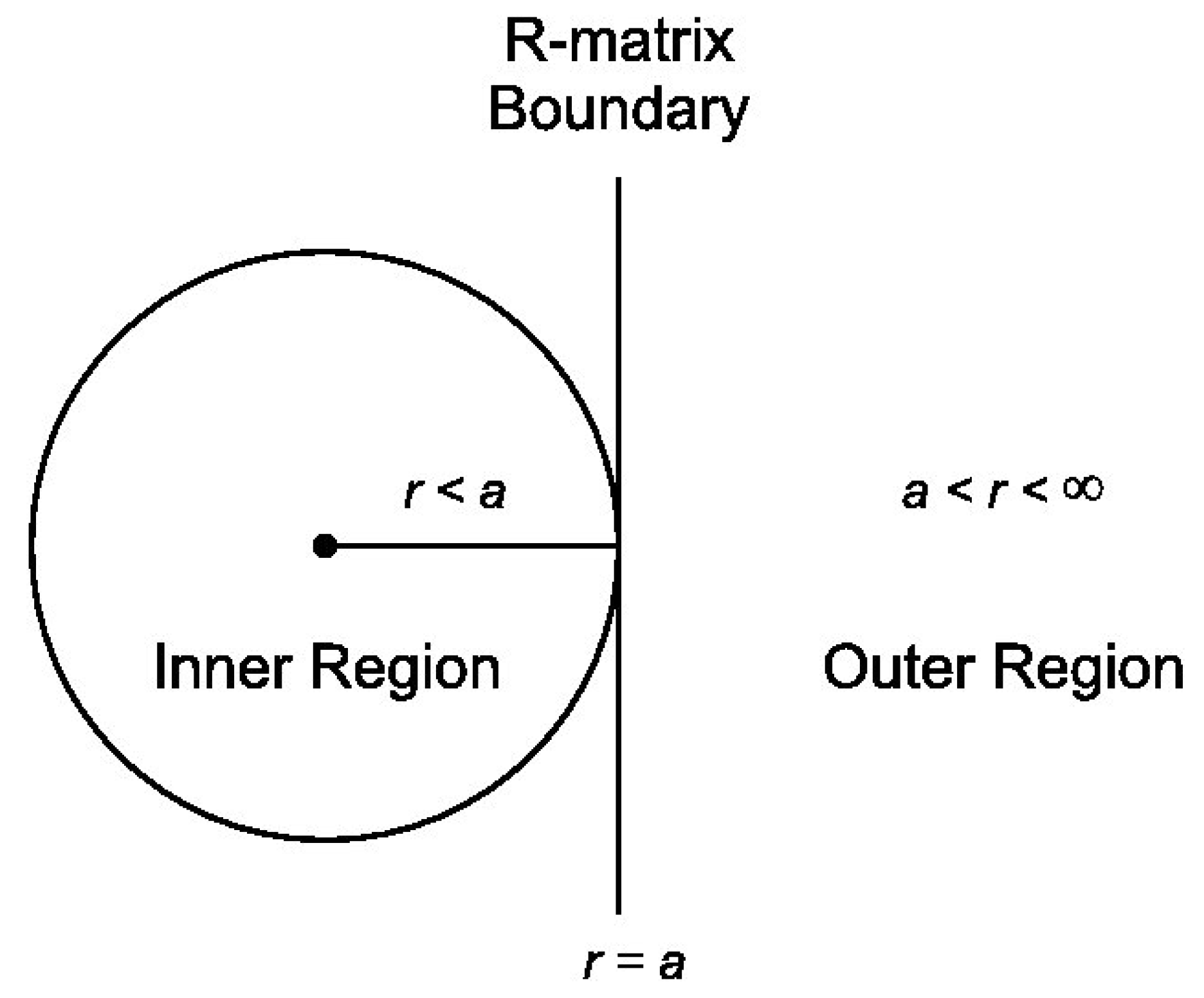
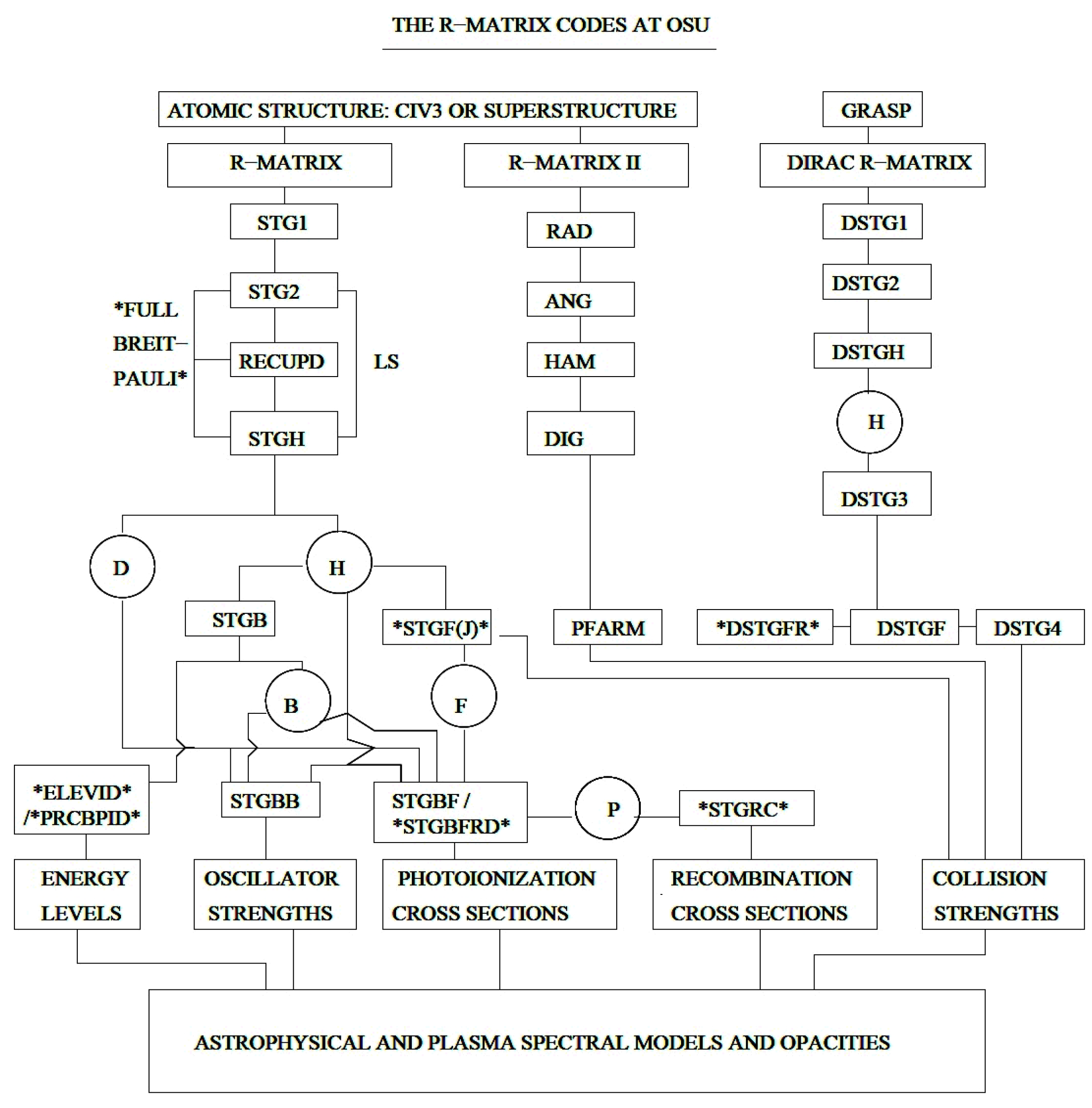
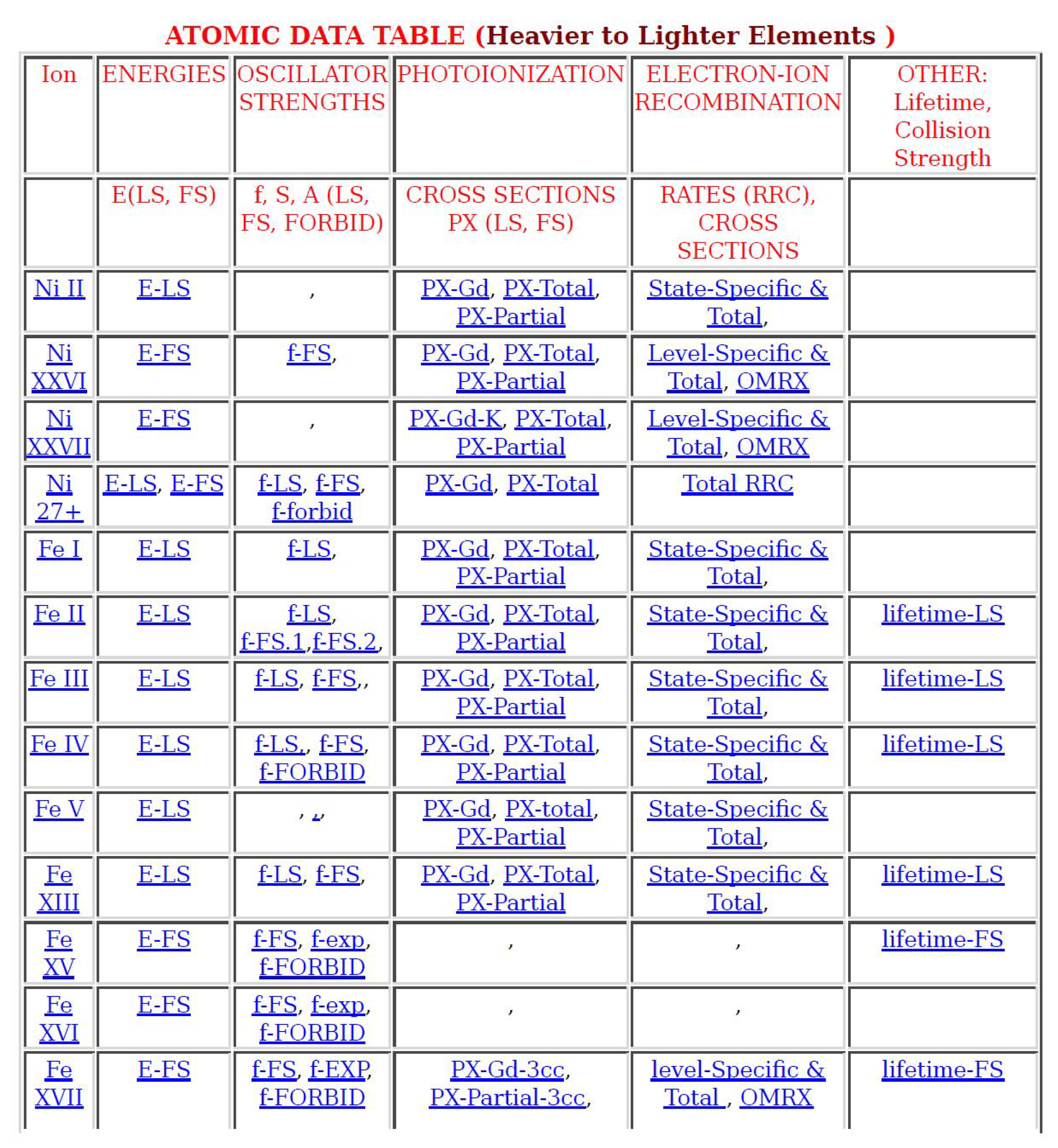
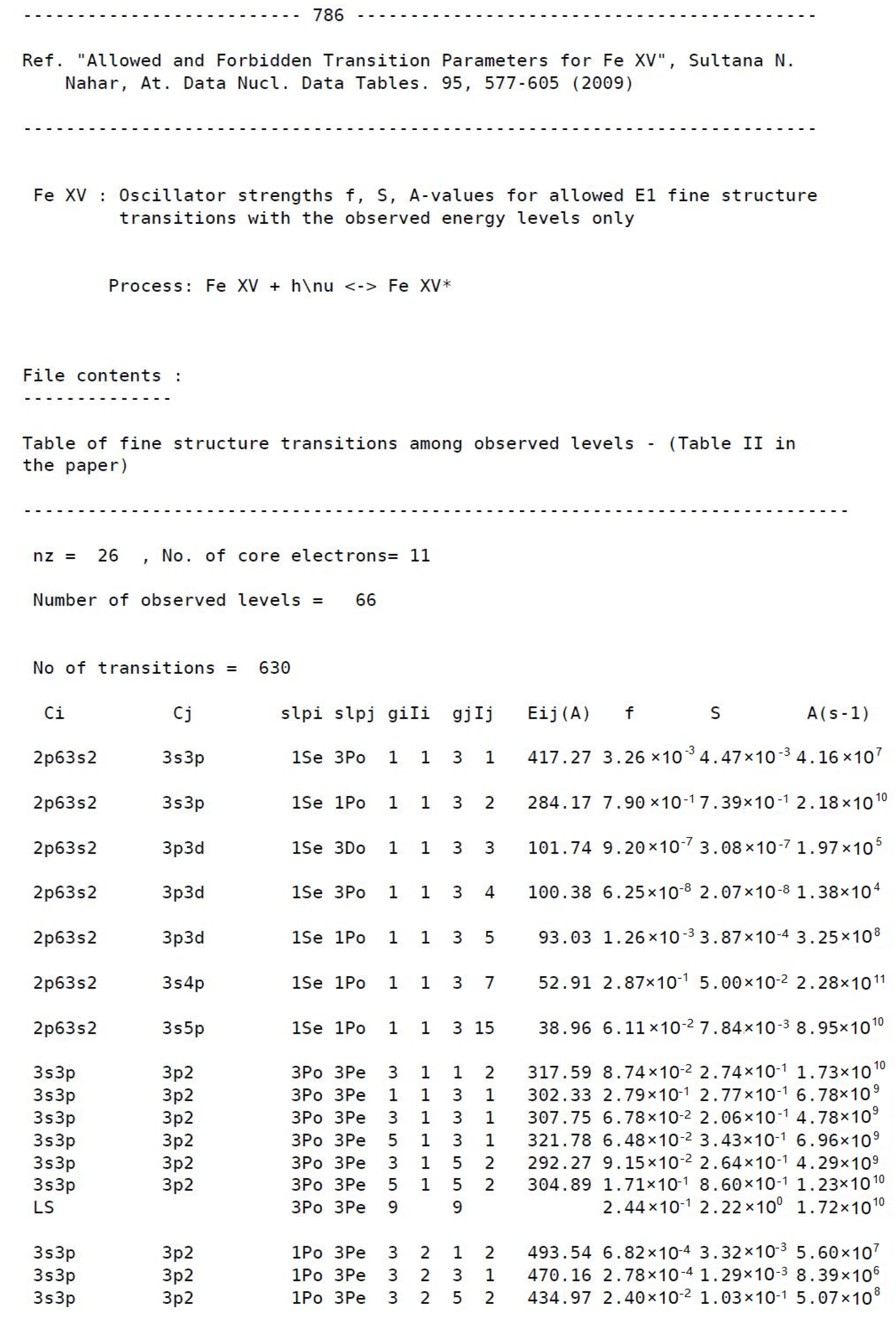

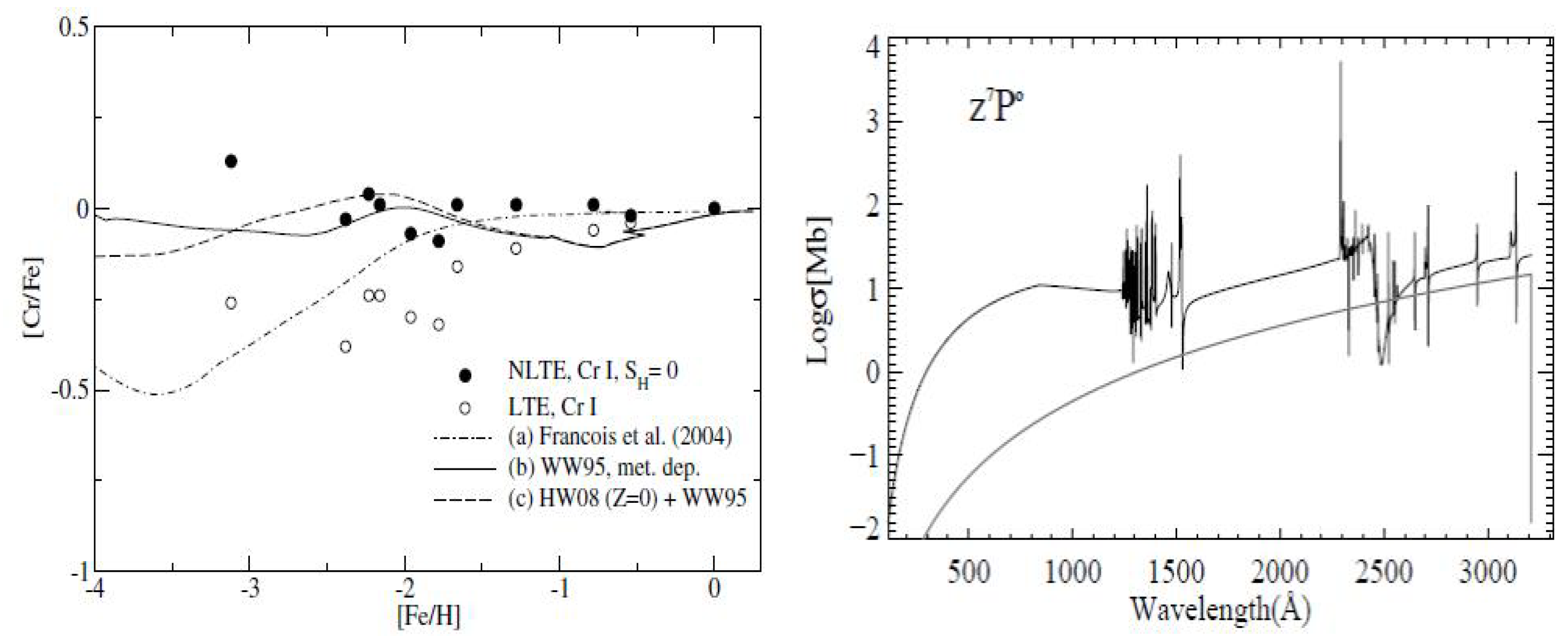
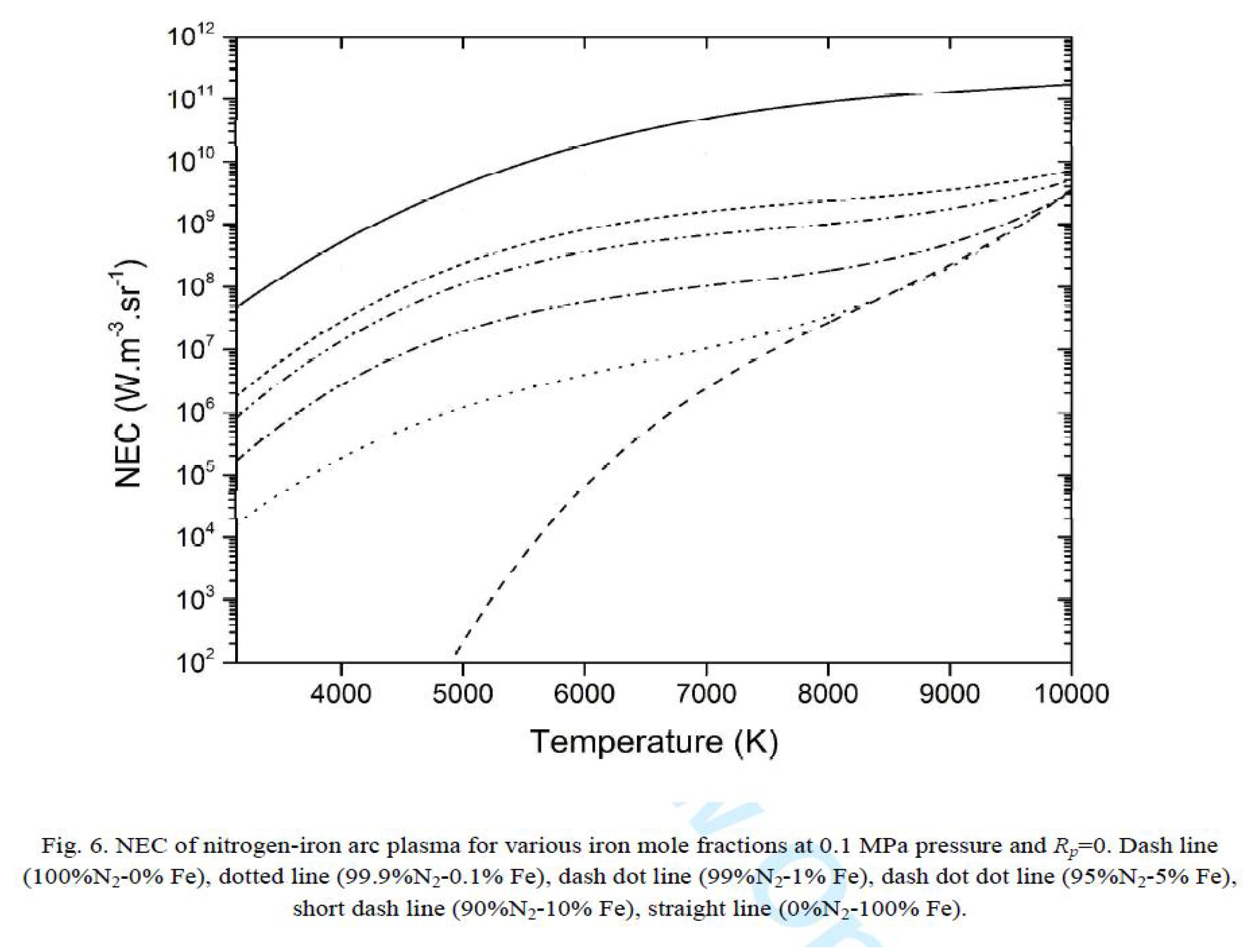
| E(Ry) | ||||||
|---|---|---|---|---|---|---|
| Nlv = 2, :P ( 3 1 )/2 | ||||||
| 2p63s2 (1Se) | 0 | 3p | 1 | −2.88230 | 2.64 | 2P o |
| 2p63s2 (1Se) | 0 | 3p | 3 | −2.86520 | 2.62 | 2P o |
| Nlv(c) = 2 : set complete | ||||||
| Eqv electron/unidentified levels, parity: e | ||||||
| 3s3p2 | 1 | −2.68030 | 2.70 | 4P e | ||
| 3s3p2 | 3 | −2.67330 | 2.71 | 4P e | ||
| 3s3p2 | 5 | −2.66410 | 2.71 | 4P e | ||
| Nlv(c) = 3 : set complete | ||||||
| Nlv = 9, : S ( 1 )/2 P ( 3 1 )/2 D ( 5 3 )/2 F ( 7 5 )/2 G ( 9 7 )/2 | ||||||
| 3p2 (1De) | 2 | 3d | 5 | −1.96549 | 2.84 | 2DF e |
| 3p2 (1De) | 2 | 3d | 7 | −1.95955 | 2.83 | 2FG e |
| 3p2 (1De) | 2 | 3d | 7 | −1.94588 | 2.85 | 2FG e |
| 3p2 (1De) | 2 | 3d | 9 | −1.94215 | 2.84 | 2G e |
| 3p2 (1De) | 2 | 3d | 3 | −1.94120 | 2.83 | 2D e |
| 3p2 (1De) | 2 | 3d | 5 | −1.93740 | 2.85 | 2D e |
| 3p2 (1De) | 2 | 3d | 1 | −1.88526 | 2.85 | 2SP e |
| 3p2 (1De) | 2 | 3d | 1 | −1.87559 | 2.86 | 2SP e |
| 3p2 (1De) | 2 | 3d | 3 | −1.87283 | 2.88 | 2PD e |
| Nlv(c) = 9 : set complete | ||||||
| 26 | 13 | ||||||
|---|---|---|---|---|---|---|---|
| I | I | (Ry) | (Ry) | ||||
| 2 0 2 1 79 82 6478 = gi Pi gk Pk Ni Nk NN | |||||||
| 1 | 1 | 451.12 | −2.6803 | −2.8823 | 5.777 | 1.716 | 1.893 |
| 1 | 2 | 237.74 | −2.6803 | −2.2970 | −1.231 | 1.927 | 1.453 |
| 1 | 3 | 211.68 | −2.6803 | −2.2498 | −2.819 | 3.929 | 4.197 |
| 1 | 4 | 207.44 | −2.6803 | −2.2410 | −1.458 | 1.991 | 2.259 |
| 1 | 5 | 161.86 | −2.6803 | −2.1173 | −4.713 | 5.023 | 1.200 |
| 1 | 6 | 19.07 | −2.6803 | −2.0978 | −4.846 | 6.086 | 8.890 |
| 1 | 7 | 82.85 | −2.6803 | −1.5804 | −5.076 | 2.769 | 4.931 |
| 1 | 8 | 82.65 | −2.6803 | −1.5777 | −1.231 | 6.699 | 1.202 |
| 1 | 9 | 81.13 | −2.6803 | −1.5571 | −1.757 | 9.386 | 1.780 |
| 1 | 10 | 79.57 | −2.6803 | −1.5351 | −1.716 | 8.989 | 1.807 |
© 2020 by the author. Licensee MDPI, Basel, Switzerland. This article is an open access article distributed under the terms and conditions of the Creative Commons Attribution (CC BY) license (http://creativecommons.org/licenses/by/4.0/).
Share and Cite
Nahar, S. Database NORAD-Atomic-Data for Atomic Processes in Plasma. Atoms 2020, 8, 68. https://doi.org/10.3390/atoms8040068
Nahar S. Database NORAD-Atomic-Data for Atomic Processes in Plasma. Atoms. 2020; 8(4):68. https://doi.org/10.3390/atoms8040068
Chicago/Turabian StyleNahar, Sultana. 2020. "Database NORAD-Atomic-Data for Atomic Processes in Plasma" Atoms 8, no. 4: 68. https://doi.org/10.3390/atoms8040068
APA StyleNahar, S. (2020). Database NORAD-Atomic-Data for Atomic Processes in Plasma. Atoms, 8(4), 68. https://doi.org/10.3390/atoms8040068





